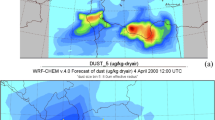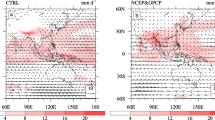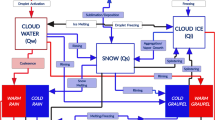Abstract
We examine the sensitivities of heterogeneous sulfate chemistry in a mid-latitude and tropical storm using a cloud resolving model. Both thermodynamic environments show unstable conditions favorable for development of intensive convection, with more CAPE in tropical compared to mid-latitude storm. Compared with the observed severe storms, modeled results show a relatively good agreement with the radar and surface chemical observations. Microphysical evaluation indicates that the accretion and autoconversion appear to be most important processes in such considered clouds. This sensitivity simulation is an upper bound for conversion of S (IV) to sulfate. The tropical convective storm produces for about 2.5 times more sulfate compared to mid-latitude storm and converts more SO2 to sulfate, increasing wet deposition of sulfur. The results for a midlatitude run indicate that aerosol nucleation and impact scavenging account for between 18.9% and 28.9% of the in-cloud sulfate ultimately deposited. As a result of greater rainfall efficiency, tropical storm shows about two times higher sub-cloud scavenging rate than mid-latitude storm. The oxidation of S (IV) to SO4 −2 in cloud droplets and in precipitation is found to be dominant in both convective storms accounting almost with the same percentage contribution of 45.4% and 46.3% to sulfur deposition, respectively. In-cloud oxidation contribute a larger fraction of the total amount of sulfur deposited in tropical case (29.2%) when compared to the mid-latitude case (11.8), respectively. Neglecting aqueous-phase chemistry in ice-phase hydrometeors in both convective clouds led to overpredict deposition of about 40% to 33% relative to the base runs.
Similar content being viewed by others
References
Barth, M. C., 1994: Numerical modelling of sulfur and nitrogen chemistry in a narrow cold-frontal rainband: The impact of meteorological and chemical parameters. J. Appl. Meteor., 33, 855–868.
—, A. L. Stuart, and W. C. Skamarock, 2001: Numerical simulation of the July 10 Stratospheric-Tropospheric Experiment: Radiation, Aerosols, and Ozone/Deep Convection storm: Redistribution of soluble tracers. J. Geophys. Res., 106, 12,381–12,400.
—, and Coauthors, 2007: Cloud-scale model intercomparison of chemical constituent transport in deep convection. Atmos. Chem. Phys., 7, 4709–4731.
Betterton, E. A. and D. J. Anderson, 2001: Autoxidation of N(III), S(IV), and other species in frozen solution — A possible pathway for enhanced chemical transformation in freezing systems. J. Atmos. Chem., 40, 171–189.
Chatfield, R. B., and P. J. Crutzen, 1984: Sulfur dioxide in remote occanic air: Cloud transport of reactive precursors. J. Geophys. Res., 89, 7111–7132.
Chaumerliac, N., E. Richard, J.-P. Pinty, and E. C. Nickerson, 1987: Sulfur scavenging in a mesoscale model with quasi-spectral microphysics: Twodimensional results for continental and maritime clouds. J. Geophys. Res., 92(D3), 3114–3126, doi:10.1029/JD092iD03p03114.
Crutzen, P. J., and M. G. Lawrence, 2000: The impact of precipitation scavenging on the transport of trace gases: A 3-dimensional model sensitivity study. J. Atmos. Chem., 37, 81–112.
Ćurić, M. and D. Janc, 1995: On the sensitivity of the continuous accretion rate equation used in bulk-water parameterization schemes. Atmos. Res., 39, 313–332.
—, and —, 1997: On the sensitivity of hail accretion rates in numerical modeling. Tellus, 49A, 100–107.
—, —, and V. Vucković, 2009: The influence of merging and individual storm splitting on mesoscale convective system formation. Atmos. Res., 93, 21–29, doi: 10.1016j.atmosres.2008.10.018.
—, and —, 2012: Differential heating influence on hailstorm vortex pair evolution. Quart. J. Roy. Meteor. Soc., 138, 72–80, doi: 10.1002/qj.918.
Durran, D. R., 1981: The effects of moisture on mountain lee waves. Ph.D. Thesis, Massachusetts Institute of Technology Boston, MA (NTIS PB 82126621).
Easter, R. C., and J. M. Hales, 1983: Interpretation of the OSCAR data for reactive gas scavenging, in Precipitation Scavenging, Dry Deposition, and Resuspension. Elsevier Sci., New York, 649–662.
kman, A., C. Wang, J. Ström, and J. Wilson, 2004: Explicit simulation of aerosol physics in a cloud-resolving model: A sensitivity study based on an observed convective cloud. Atmos. Chem. Phys., 4, 773–791.
Flossmann, A. I., 1991: The scavengit∼go f two different types of marine aerosol calculated using a two-dimensional detailed cloud model, Tellus, Scr. B. 438, 301–321.
Giorgi, F., and W. L. Chameides, 1986: Rainout lifetimes of highly soluble aerosols and gases as inferred from simulations with a general circulation model. J. Geophys. Res., 91, 14,367–14,376.
Hegg, D. A., S. A. Rutledge, and P. V. Hobbs, 1986: A numerical model for sulfur and nitrogen scavenging in narrow cold-frontal rainbands 2. discussion of chemical fields. J. Geophys. Res., 91(D13), 14,403–14,416, doi:10.1029/JD091iD13p14403.
Hsie, E.-Y., R. D. Farley, and R. D. Orville, 1980: Numerical simulation of ice-phase convective cloud seeding. J. Appl. Meteorol., 19, 950–977.
Iribarne and Barrie, 1995: The oxidation of S (IV) during riming by cloud droplets. J. Atmos. Chem., 21, 97–114.
Klemp, J. B., and R. B. Wilhelmson, 1978: The simulation of three-dimensional convective storm dynamics. J. Atmos. Sci., 35, 1070–1096.
Kreidenweis, S. M., Y. Zhang, and G. R. Taylor, 1997: The effects of clouds on aerosol and chemical species production and distribution, 2. Chemistry model description and sensitivity analysis. J. Geophys. Res., 102, 23,867–23,882.
Lin, Y. L., R. D. Farley, and H. D. Orville, 1983: Bulk water parameterization in a cloud model. J. Climate Appl. Meteor., 22, 1065–1092.
Martin, L. R., and D. E. Damaschen, 1981: Aqueous oxidation of sulfur dioxide by hydrogen peroxide at low pH. Atmos. Environ., 15, 191–195.
Orville, H. D., and F. J. Kopp, 1977: Numerical simulation of the history of a hailstorm. J. Atmos. Sci., 34, 1596–1618.
Pruppacher, H. R., and J. D. Klett, 1997: Microphysics of clouds and precipitation. 2nd ed., Kluwer Acad. Norwell, Mass.
Rutledge, S. A., D. A. Hegg, and P. V. Hobbs, 1986: A numerical model for sulfur and nitrogen scavenging in narrow cold-frontal rainbands. Part 1: Model description and discussion of microphysical fields. J. Geophys. Res., 91, 14,385–14,402.
Sato, K., T. Daimon, N. Takenaka, H. Bandow, and Y. Maeda, 1996: Decrease of solute in aqueous solution in freezing process, in Proc. from the NIPR Symposium on Polar Meteorology and Glaciology, 10, 138–148 pp.,Natl. Inst. Of Polar Res., Tokyo.
Seinfeld, J. H., 1986: Atmospheric Chemistry and Physics of Air Pollution, John Wiley, New York.
Sekhon, R. S., and R. C. Srivastava, 1970: Snow size spectra and radar reflectivity. J. Amos. Sci., 27, 299–307.
Scott B. C., and D. J. Luecken, 1992: The sensitivity of modeled sulfate wet deposition to the meteorological values used as input. Atmos. Environ., 26A(4), 559–569.
Smith, P. L, G. G. Myers, and H. D. Orville, 1975: Radar reflectivity calculations on numerical cloud models using bulk parameterization of precipitation. J. Appl. Meteorol., 14, 1156–1165.
Spiridonov, V., and M. Curic, 2003: Application of a cloud model in simulation of atmospheric sulfate transport and redistribution. Part I. Model description. Idojaras. 107, No. 2, 85–115.
—, Z. Dimitrovski, and M. Curic, 2010: A three-dimensional simulation of supercell convective storm. Adv. in Meteorol., ID 234731 doi:10.1155/2010/234731, 15 pp.
Stuart, A. L., and M. Z. Jacobson, 2003: A timescale investigation of volatile chemical retention during hydrometeor freezing: Nonrime freezing and dry growth riming without spreading. J. Geophys. Res., 108(D6), 4178.
Takenaka, N., A. Ueda, T. Daimon, H. Bandow, T. Dohmaru, and Y. Maeda, 1996: Accelerated mechanism of chemical reaction by freezing: The reaction of nitrous acid with dissolved oxygen. J. Phys. Chem., 100, 13,874–13,884.
Taylor, G. R., 1989: Sulfate production and deposition in mid-latitude continental cumulus clouds II, Chemistry model formulation and sensitivity analysis. J. Atmos. Sci., 46(13), 1991–2007.
—, S. Kreidenweis, and Y. Zhang, 1997: The effects of clouds on aerosol and chemical species production and distribution, Cloud model formulation, mixing, and entrainment. J. Geophys. Res., 102, 23,852–23,865.
Tremblay, A. and H. Leighton, 1986: A three-dimensional cloud chemistry model. J. Climate Appl. Meteor., 25, 652–671.
Wang, C. and J. S. Chang, 1993a: A three-dimensional numerical model of cloud dynamics, microphysics and chemistry, 4. Cloud chemistry and precipitation chemistry. J. Geophys. Res., 98, 16,799–16,808.
—, and —, 1993b: A three-dimensional numerical model of cloud dynamics, microphysics, and chemistry, 1. Concepts and formulation. J. Geophys. Res., 98, 14,827–17,844.
—, and P. J. Crutzen, 1995: Impact of a simulated severe local storm on the redistribution of sulfur dioxide. J. Geophys. Res., 100,D6, 11,357–11,367.
—, —, V. Ramanathan, and S. F. Williams, 1995: The role of deep convective storm over the tropical Pacific Ocean in the redistribution of atmospheric chemical species. J. Geophys. Res., 100, 11,509–11,516.
—, and R. G. Prinn, 2000: On the roles of deep convective clouds in tropospheric chemistry. J. Geophys. Res., 105, 22,269–22,297.
Yin, Y., D. J. Parker, and K. S. Carslaw, 2001: Simulation of trace gas redistribution by convective clouds-Liquid phase processes. Atmos. Chem. Phys., 1, 19–36.
Xu, A., and G. Carmichael, 1999: An assessment of sulfur deposition in Asia. Atmos. Environ., 33, 3473–3486.
Author information
Authors and Affiliations
Corresponding author
Rights and permissions
About this article
Cite this article
Spiridonov, V., Ćurić, M. Examination of sulfate chemistry sensitivity in a mid-latitude and tropical storm using a cloud resolving model. Asia-Pacific J Atmos Sci 48, 391–410 (2012). https://doi.org/10.1007/s13143-012-0036-0
Received:
Revised:
Accepted:
Published:
Issue Date:
DOI: https://doi.org/10.1007/s13143-012-0036-0




